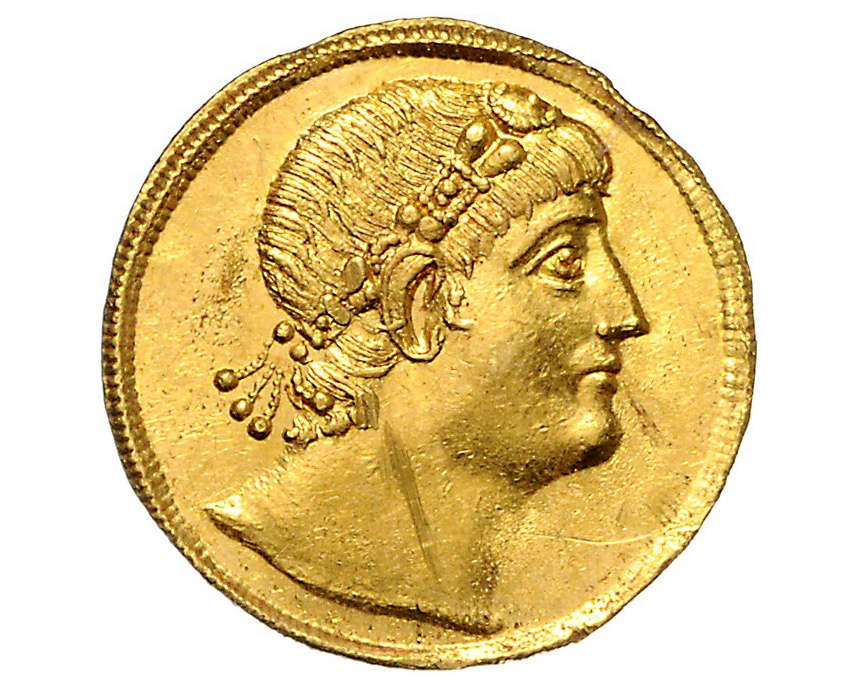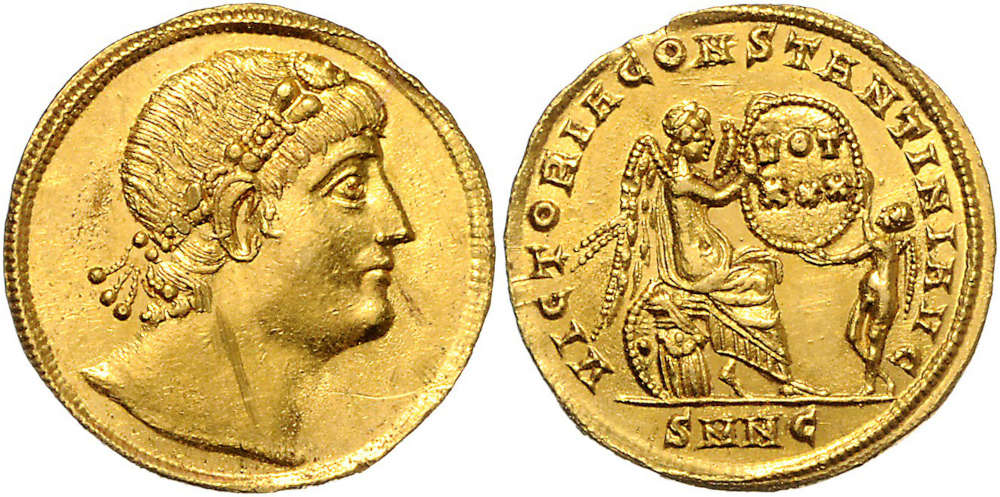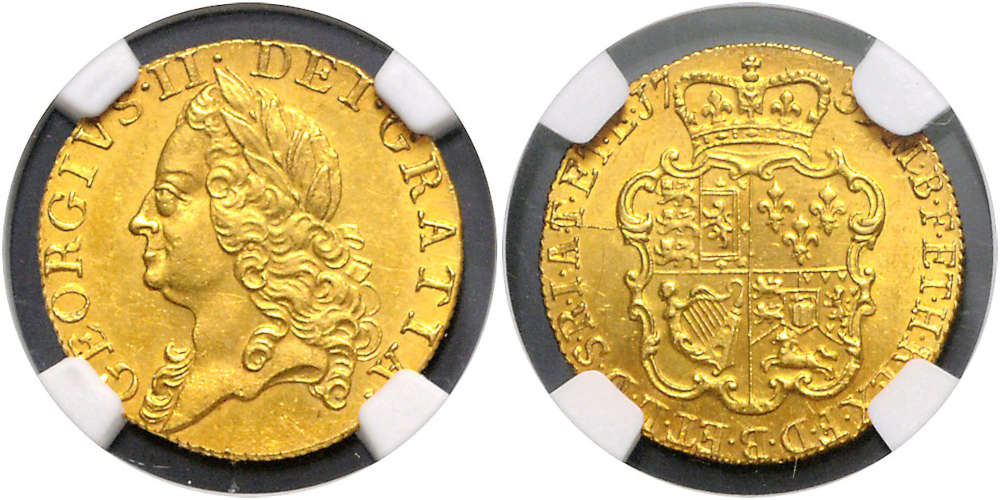Emporium Hamburg’s Auction 106 “Coins & Medals”
Emporium Hamburg
Auction 106
Coins
13.-16. May 2024
Online
In May, coins and medals once again take center stage at Emporium Hamburg: the Spring Auction 106 begins! From May 13th to 16th, 2024, the history of humanity will be brought to life in its numismatic form. From antiquity to foreign lands to the German territories – as usual, the catalog covers a wide selection.
Traditionally, antiquity opens the auction with a variety of Celtic staters and quinaries, ancient coins from Greece and Asia Minor, as well as coins from the ancient Orient. The first highlights are found in the Roman Empire, including a sestertius struck under Lucius Verus in 164/165 AD and unique in its condition ef-unc (Lot 417). Furthermore, a significant number of denarii and tetradrachms from Caracalla (Lots 446-494) and antoniniani from Gordian III. (Lots 559-600) are listed.
- Lot 73 Macedonia, Philip III. (323-317 BC). AV Stater, Lampsakos. Condition: ef. Estimate: 1,800 EUR.
- Lot 163 Cilicia / Incertum. AR Stater (ca. 465-430 BC), Attribution uncertain, as unpublished. Condition: vf-ef. Estimate: 2,500 EUR.
- Lot 417 Roman Empire, Lucius Verus (161-169). AE Sestertius, TRP V IMP II = 164/65, Rome. Unique in condition. Condition: ef-unc. Estimate: 9.600 EUR.
Constantine the Great introduced a series of new currencies in silver and gold. A new nominal in silver, the Miliarense (Lot 706), was created, and in gold, the Solidus was introduced, translated as “the Stable” (Lot 705). It corresponded to a value of 5 Aurei and was intended to replace them. The gold coins were mostly minted by a mobile mint and depended on the emperor’s location. Nicomedia was the capital of the Eastern Roman Empire for a long time before the center was moved to the newly founded Constantinople. Nicomedia became Constantine’s death place in 337 AD, shortly after he received his baptism on Pentecost.
- Lot 705 Roman Empire, Constantine the Great. AV Solidus (335 AD), SMNC = Nicomedia. Condition: fine hairlines, ef. Estimate: 28,500 EUR.
- Lot 706 Roman Empire, Constantine the Great. AR Miliarense (335 AD), TS = Thessalonica. Condition: fine hairlines, ef. Estimate: 17,500 EUR.
The Byzantine coins (Lots 759-866) feature a selection of Solidi, Scyphates, and Hyperpyrons, ranging from Anastasius I (491-518 AD) to Andronicus II and Michael IX (1295-1320).
- Lot 797 Byzantine Empire, Phocas (602-610 AD). AV Solidus, CONOB = Constantinople. Condition: unc. Estimate: 750 EUR.
- Lot 843 Byzantine Empire, Romanos III Argyrus (1028-1034). AV Histamenon nomisma = Scyphat, Constantinople. Condition: fine hairlines, ef. Estimate: 500 EUR.
In the foreign section of this auction, there is no specific focus; however, the country selection resembles a world tour: starting in Egypt, stopping in Chile, transferring to France, a brief excursion to India, a jump over to Switzerland, and the final landing in the United States.
- Lot 1076 Great Britain, George II (1727-1760). Guinea 1759. From the Erwin Warth Collection. Condition: attr. piece, NGC MS64. Estimate: 13,000 EUR.
- Lot 1110 India, Victoria (1837-1901). 1 Mohur 1841, East India Company. Condition: attr. piece, unc. Estimate: 6,800 EUR.
- Lot 1250 Province of the United Netherlands. Ducat 1792, “Silver Rider”. Condition: fine hairlines, near unc. Estimate: 2,750 EUR.
- Lot 1302 Poland, Sigismund III (1587-1632). Taler 1628 II, Bromberg. Condition: vf. Estimate: 1,450 EUR.
- Lot 1391 Switzerland. 100 Francs 1925 B. Condition: NGC MS-62. Estimate: 18,500 EUR.
- Lot 1412 Thailand, Province of Chiengmai (1615-1768). AR Tamlung = Tok or Pig’s Nose Money, vaulted shape. Condition: ef. Estimate: 50 EUR.
- Lot 1478 Vatican, Pius IX (1846-1878). 100 Lire 1869. Condition: ef. Estimate: 3,800 EUR.
- Lot 1562 United States of America / Hawaii, Kalakaua (1874-1891). Dollar 1883, Akahi Dala. Condition: PCGS AU50. Estimate: 1,600 EUR.
In the Habsburg territories, the very rare 10 Ducats of Ferdinand III (1637-1657) stand out (Lot 1680). The obverse features a bust of Jesus Christ in a laurel wreath with the inscription SALVATOR MVNDI (“Savior of the World”). The so-called Salvator coins were donated from 1575 as merit coins of the city of Vienna and given as an honor to important officials for New Year.
- Lot 1680 House of Habsburg, Ferdinand III (1637-1657). 10 Ducats n. d., Vienna. Condition: very rare, vf-ef. Estimate: 10,000 EUR.
- Lot 1707 House of Habsburg, Joseph I. (1705-1711). Reichstaler 1707, Hall. Condition: near ef. Estimate: 500 EUR.
The German territories include pieces in gold and silver from Old Germany, the German Empire, the Weimar Republic to modern mintings from East and West Germany.
- Lot 1763 Archbishopric of Salzburg, Max Gandolph Count Küenburg (1668-1687). 5 Ducats 1668. Condition: vf. Estimate: 5,000 EUR.
- Lot 1796 Augsburg. Reichstaler 1626 with the title Ferdinand II. Condition: near ef. Estimate: 600 EUR.
- Lot 1810 Bavaria, Maximilian I (1598-1651). 5 Ducats 1640. Refortification of the city of Munich. Condition: rare, attr. piece, ef-unc. Estimate: 20,000 EUR
- Lot 1866 Brandenburg-Prussia, Frederick II (1740-1786). Taler 1750 A, Berlin. Condition: beautiful patina, vf-ef. Estimate: 450 EUR.
For the Brunswick-Lüneburg collecting area, specimens in extraordinary size are available: löser coins from both the Lüneburg-Celle line and the Wolfenbüttel line. Löser coins were originally created in the 16th century as monetary hoarding coins but evolved over time into representative and decorative showpieces. The löser coin for 3 Reichstalers from 1654 shows a newly introduced depiction under Duke Christian Ludwig (1648-1665): a jumping horse above the mine, specifically above the Harz mining area (Lot 1930). The löser coins always stood as a sign of Brunswick’s prosperity, secured by the rich silver deposits.
- Lot 1930 Brunswick and Lüneburg, Lüneburg-Celle line, Christian Ludwig (1648-1665). Löser for 3 Reichstalers 1654, Clausthal. Condition: extremely rare, vf. Estimate: 4,200 EUR.
- Lot 2002 Hamburg, City. Reichstaler 1589 with the title Rudolf II. Condition: beautiful patina, ef. Estimate: 700 EUR.
- Lot 2089 Hildesheim, City. 5 Goldgulden 1528 (minted 1614-1620) with the title Charles V. Condition: fine hairlines, near ef. Estimate: 17,500 EUR.
- Lot 2173 Rottweil, royal mint. Bracteate n. d. (1270/80). Condition: ef. Estimate: 200 EUR.
- Lot 2383 Hanover, George III. (1760-1820). Taler 1801 C, Hanover. Condition: very rare, NGC UNC DETAILS, Rev Spot Removed. Estimate: 5,000 EUR.
- Lot 2629 Würzburg, City, Ludwig II. of Bavaria (1864-1886). New Year Goldgulden undated (1864) SPQW. Condition: minor rim fault, ef. Estimate: 3200 EUR.
- Lot 2990 Waldeck and Pyrmont, Frederick (1893-1918). 20 Mark 1903 A. Condition: first strike, near unc. Estimate: 10,000 EUR.
The featured piece 15 Rupien 1916 T (Lot 3131) showcases a special piece of colonial history in German East Africa: the mint was the railway workshop of the “Kironda Gold Mines Company” in Tabora. The dies for the 15 Rupien 1916 were designed by R. Vogt. The gold required for minting was procured from the Sekenke Gold Mines, located approximately 170 kilometers northeast of Tabora and considered the most significant gold sources in German East Africa.
The decision to mint these golden emergency coins was made for two central reasons. Firstly, coinage aimed to alleviate the acute shortage of money and be used for wage payments. Secondly, in 1916, due to the impending occupation of German East Africa by British and Belgian troops, it was impossible to transport the acquired gold to Germany. If the government had kept this gold, it would have been immediately confiscated by the victorious powers. In contrast, gold held in private ownership remained untouched.
In July 1916, coinage was discontinued due to the advance of Belgian troops. This led to the 15 Rupien gold piece of the German East African Bank becoming a valuable rarity since it represented the only colonial German gold coin as emergency money.
- Lot 3131 German East Africa. 15 Rupien 1916 T. Condition: fine hairlines, ef. Estimate: 3,500 EUR.
Medals have gained significant importance in recent years and are increasingly at the center of numismatic attention. With their versatile and detailed depictions, they capture the spirit of past eras particularly well. Among the thematic medals is a variety of orders from different countries, each grouped into lots of several pieces (Lots 1611-1641).
- Lot 1122 (rectangular) Italy, Umberto I. (1878-1900). Bronze plaque 1900 by Johnson on his death. Reverse: Mourning Roma at the coffin in the Pantheon. Condition: near ef. Estimate: 70 EUR.
- Lot 1311 Polish People’s Republic, 1952-1989. Cupronickel medal 1954 by J. Goslawski on the 500th anniversary of the return of Gdansk to Poland. Polonia enthroned with coat of arms receiving sailor and fisherman as symbol for Gdansk. Reverse: City view with Gdansk coat of arms between two lions. Condition: patina spots, beautiful toning, ef. Estimate: 60 EUR.
- Lot 1578 Germany, Bronze cast medal 1942 on Field Marshal Fedor von Bock and the encirclement in Kharkov. Condition: ef. Estimate: 500 EUR.
- Lot 2032 Hamburg, City. Silver medal 1803 on the 1000th anniversary of the city. City view with Jungfernstieg and Binnenalster. Condition: fine hairlines, ef. Estimate: 100 EUR.
- Lot 2195 Saxony, Friedrich August III. (1763-1806). Silver medal 1786 in the weight of a double taler by Stieler as yield of the Beschert Glück mine. Condition: very rare, fine hairlines, near ef-unc. Estimate: 4,250 EUR.
Auction 106 will take place live online on Auctionmobility starting on May 13, 2024, at 1:00 pm (CET). Advance bids are accepted on the usual platforms as well as by phone and in writing. If you have any questions regarding previewing, catalog ordering, or advance bids, please feel free to contact us. Write to numis@emporium-hamburg.com or call us at +49 40/257 99-137.











